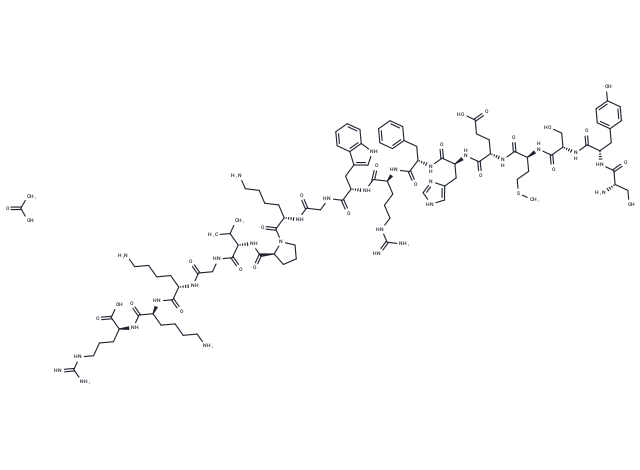Shopping Cart
- Remove All
 Your shopping cart is currently empty
Your shopping cart is currently empty

ACTH (1-17) acetate is a potent agonist at the human melanocortin 1 (MC1) receptor with high affinity(Ki = 0.21 nM).

| Pack Size | Price | Availability | Quantity |
|---|---|---|---|
| 1 mg | $122 | In Stock | |
| 5 mg | $411 | In Stock | |
| 10 mg | $587 | In Stock | |
| 25 mg | $1,057 | In Stock | |
| 50 mg | $1,585 | In Stock | |
| 100 mg | $2,377 | In Stock |
| Description | ACTH (1-17) acetate is a potent agonist at the human melanocortin 1 (MC1) receptor with high affinity(Ki = 0.21 nM). |
| Targets&IC50 | MC1R (human):0.21 nM(Ki) |
| In vitro | ACTH (1-17) acetate induces a slight and not significant increase in growth hormone secretion even when micromolar concentrations of the peptide are employed in rat pituitary cultures[1]. ACTH (1-17) acetate showed an affinity for alpha-MSH with Ki of 0.13±0.005 nM[1]. |
| In vivo | When nocturnal animals became active, inhibition of DNA markers was noted when ACTH (1-17) acetate was administered 2 hours after the start of the daily dark span. When administered during this circadian phase, particularly larger doses were associated with a 24-hour lasting inhibition of DNA markers. When the same dose was injected 4 hours earlier, the inhibitory effect was much shorter [2]. |
| Molecular Weight | 2153.47 |
| Formula | C97H149N29O25S |
| Smiles | CC(O)=O.N=C(N)NCCC[C@@H](C(O)=O)NC([C@H](CCCCN)NC([C@H](CCCCN)NC(CNC([C@H](C(C)C)NC([C@H]1N(C([C@H](CCCCN)NC(CNC([C@H](CC2=CNC3=C2C=CC=C3)NC([C@H](CCCNC(N)=N)NC([C@H](CC4=CC=CC=C4)NC([C@H](CC5=CNC=N5)NC([C@H](CCC(O)=O)NC([C@H](CCSC)NC([C@H](CO)NC([C@H](CC6=CC=C(O)C=C6)NC([C@H](CO)N)=O)=O)=O)=O)=O)=O)=O)=O)=O)=O)=O)CCC1)=O)=O)=O)=O)=O |
| Storage | store at low temperature,keep away from moisture | Powder: -20°C for 3 years | In solvent: -80°C for 1 year | Shipping with blue ice. |

Copyright © 2015-2025 TargetMol Chemicals Inc. All Rights Reserved.